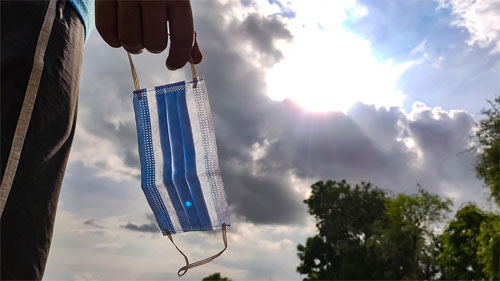More than 80% of Covid patients are vitamin D deficient
Aside from insulin resistance, vitamin D deficiency has emerged as a primary risk factor for severe Covid-19 infection and death. Higher vitamin D levels have even been shown to lower your risk of testing positive for the virus in the first place.

Getting the word out about this – especially to the Black community and the elderly in nursing homes – could have a significant impact on future hospitalization and death rates from this virus.
If you have a loved one in a nursing home, taking the time to talk to the medical management about vitamin D testing and supplementation could also make a big difference in the general health of all the residents, as vitamin D is something that can strengthen your immune system in a matter of a few weeks and has many health benefits beside lowering your risk of viral illness.
Vast majority of Covid-19 patients have vitamin D deficiency
According to a Spanish study published online on October 27, 2020, in The Journal of Clinical Endocrinology & Metabolism, 82.2% of Covid-19 patients tested were found to be deficient in vitamin D, the medical term for which is 25-hydroxycholecalciferol (25OHD).
The researchers compared the vitamin D levels of 216 Covid-19 patients and 197 population-based controls, finding that hospitalized Covid-19 patients had a higher prevalence of deficiency and had lower vitamin D levels overall. As reported by the authors: “In Covid-19 patients, mean± SD 25OHD levels were 13.8±7.2 ng/ml, compared to 20.9 ±7.4 ng/ml in controls. 25OHD values were lower in men than in women. Vitamin D deficiency was found in 82.2% of Covid-19 cases and 47.2% of population-based controls.
25OHD inversely correlate to serum ferritin and D-dimer levels. Vitamin D deficient Covid-19 patients had a greater prevalence of hypertension and cardiovascular diseases, raised serum ferritin and troponin levels, as well as a longer length of hospital stay than those with serum 25 OHD levels ≥ 20 ng/ml.”
While this particular study failed to find a correlation between vitamin D levels and disease severity, other studies have shown patients with higher levels do tend to have milder disease. In fact, one such study found your risk of developing a severe case of, and dying from, Covid-19 virtually disappears once your vitamin D level gets above 30 ng/mL (75 nmol/L).
Vitamin D’s impact on COVID-19
Back in June 2020, it has been launched an information campaign about vitamin D that included the release of a downloadable scientific report. This report, as well as a two-minute COVID risk quiz is available on StopCovidCold.com.
October 31, 2020, a review paper “Evidence Regarding Vitamin D and Risk of Covid-19 and Its Severity,” co-written with William Grant, Ph.D., and Dr. Carol Wagner, both of whom are part of the GrassrootsHealth expert vitamin D panel, was also published in the peer-reviewed journal Nutrients. You can read the paper for free on the journal’s website.
As noted in that paper, dark skin color, increased age, pre-existing chronic conditions and vitamin D deficiency are all features of severe COVID disease, and of these, vitamin D deficiency is the only factor that is modifiable. As such, it would be foolish to ignore, especially since vitamin D supplements are readily available and low cost.
Vitamin D can reduce your risk of Covid-19 and other respiratory infections via several different mechanisms, including but not limited to the following, all of which are discussed in greater detail in the paper:
– Reducing the survival and replication of viruses
– Reducing inflammatory cytokine production
– Maintaining endothelial integrity (Endothelial dysfunction contributes to vascular inflammation and impaired blood clotting, two hallmarks of severe COVID-19)
– Increasing angiotensin-converting enzyme 2 (ACE2) concentrations. As explained in the paper: “Angiotensin II is a natural peptide hormone best known for increasing blood pressure through stimulating aldosterone. ACE2 normally consumes angiotensin I, thereby lowering its concentrations. However, SARS-CoV-2 infection downregulates ACE2, leading to excessive accumulation of angiotensin II. Cell cultures of human alveolar type II cells with vitamin D have shown that the SARS-CoV-2 virus interacts with the ACE2 receptor expressed on the surface of lung epithelial cells. Once the virus binds to the ACE2 receptor, it reduces its activity and, in turn, promotes ACE1 activity, forming more angiotensin II, which increases the severity of COVID-19.”
Vitamin D also boosts your overall immune function by modulating your innate and adaptive immune responses, reduces respiratory distress and improves overall lung function, helps produce surfactants in your lungs that aid in fluid clearance.
It lowers your risk of comorbidities associated with poor Covid-19 prognosis, including obesity, Type 2 diabetes, high blood pressure and heart disease. All of these factors make it an important component of Covid-19 prevention and treatment.
Criteria for causality satisfied
As of September 27, 2020, the data from 14 observational studies suggest that vitamin D blood levels are inversely correlated with the incidence and/or severity of COVID-19, and the evidence currently available generally satisfies Hill’s criteria for causality in a biological system, which include:
– Strength of association – Consistency of evidence
– Temporality – Biological gradient
– Plausibility (e.g., mechanisms) – Coherence (although it still needs to be verified experimentally).
COVID-19 features related to vitamin D status

In the paper are reviewed several features of Covid-19 that are indicative of vitamin D deficiency. For starters, SARS-CoV-2 emerged in the winter in the northern hemisphere, and progressing into summer, positive tests, hospitalizations and death rates fell. So, generally, Covid-19 prevalence has been inversely correlated with solar UVB doses and vitamin D production.
Secondly, people with darker skin have higher Covid-19 case and death rates than Caucasians. Vitamin D is produced in your skin in response to sun exposure, but the darker your skin, the more sun exposure you need in order to maintain an optimal vitamin D level. While a light-skinned individual may need only 10 to 15 minutes a day, a person with very dark skin may need upward of 1.5 hours. As a result, vitamin D deficiency tends to be far higher among Blacks and dark-skinned Hispanics.
Thirdly, one of the lethal hallmarks of Covid-19 is the cytokine storm that can develop in severe cases, which manifests as hyperinflammation and tissue damage. Vitamin D is known to regulate inflammatory cytokine production, thereby lowering this risk. Lastly, vitamin D is an important regulator of your immune system, and dysregulation of the immune system is a hallmark of severe COVID-19.
Findings from largest study to date
The largest observational study to date was published in the journal PLOS ONE, September 17, 2020. It looked at data for 191,779 American patients with a mean age of 50 who were tested for SARS-CoV-2 between March and June 2020 and had had their vitamin D tested sometime in the preceding 12 months. It found:
– 12.5% of patients who had a vitamin D level below 20 ng/ml (deficiency) tested positive for SARS-CoV-2
– 8.1% of those who had a vitamin D level between 30 and 34 ng/ml (adequacy) tested positive for SARS-CoV-2
– Only 5.9% of those who had an optimal vitamin D level of 55 ng/ml or higher tested positive for SARS-CoV-2
According to the authors: “SARS-CoV-2 positivity is strongly and inversely associated with circulating 25(OH)D levels, a relationship that persists across latitudes, races/ethnicities, both sexes, and age ranges. Our findings provide impetus to explore the role of vitamin D supplementation in reducing the risk for SARS-CoV-2 infection and Covid-19 disease.”
This inverse relationship between vitamin D and SARS-CoV-2 infection rates may be due to the fact that vitamin D reduces survival and replication of the virus by activating immune cells to produce the antimicrobial and antiviral peptides cathelicidin and defensins, and increasing concentrations of free ACE2, which prevents the virus from entering cells via the ACE2 receptor.
yogaesoteric
February 18, 2021
